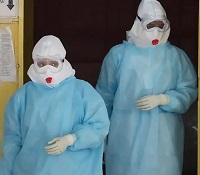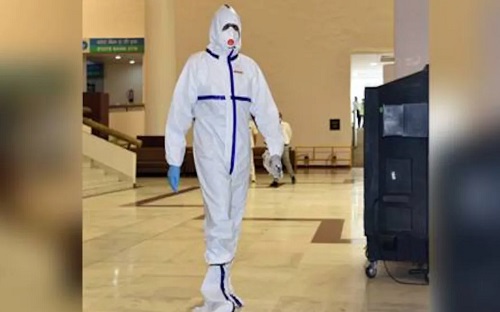FW
In order to revamp its business, JCPenney plans to shut 13 more stores in the first week of July. Last month, the retailer had announced its plans to shut 192 stores by February 2021 and then close another 50 stores in 2022. It recently released a list of 154 stores and initiated liquidation sales at 136 locations.
The 13 stores that the retailer plans to close are located in the Mid Valley Mall, Sunnyside, WA; Greenville West Mall, Greenville, MI; Owosso in MI; Omache Shopping CTR, OMAK, WA; Big Rapids, MI; Northtown Village, Alma, MI; Bay City Mall, Bay City, MI; MT Pleasant Shopping CTR, MT Pleasant, MI; Mall at Prince George’s, Hyattsville, MD; Meridian Mall, Okemos, MI; South Shore Mall, Bay Shore, NY; Poughkeepsie Galleria, Poughkeepsie, NY and Sun Valley Mall, Concord.
The global functional apparel market size is expected to grow at a CAGR of 7.4 per cent between 2020 and 2027 to be worth around $550 billion by 2027, says a research report by US-based Acumen Research and Consulting. The report expects suppliers to shift away from China with the intention of reducing potential market costs and growing the cluster in a given country to ease supply chain.
The report says, increased awareness about healthy lifestyle led to a rise in demand for sportswear, which in turn will allow the global market for functional apparel to expand. Moreover, the growth of the target market is driven by a growing number of sports and other recreational events, including trekking, cycling, etc. Growing demand for convenient apparel and accessories, as well as the rising youth participation in various fields of sport, are two of the main factors for the growth of the target market.
Another element expected to boost demand for medical wearing laboratory apparel is increased research and development activities in medical laboratories to propel growth of the world market. Increasing mobile and Internet penetration boosts demand for many functional wear products like activewear, wear safety, etc., which, on the other hand, are projected to drive growth of the global market for functional wear over the anticipated period.
A second aspect projected to impede growth of the target market is the emergence of replication goods at a lower rate.
Resorting to unfair trade practices, fast fashion brands are not just cancelling orders but also refusing to pay their workers in India. A recent example of this is H&M which cancelled orders after a major chunk of it was completed. Most of these fast-fashion brands and companies, and even some high fashion brands, do not have their own factories or ateliers. Instead, a bulk of the manufacturing work is outsourced to India, Bangladesh, and other developing nations where the labor is cheap and raw material is easily procurable.
The factories where the work is outsourced to, is responsible for procuring the raw materials, creating a product, say jeans or a shirt, ship a batch of the finished product to the nearest headquarter of the brand, where it undergoes a quality and check, and then sent across the world. Normally, once the finished product passes inspection, the brands release a majority of the payment. Few brands, do give the factories a token advance, but not all of them. Workers in these factories are barely given the minimum wages. On top of that, most of these factories flout basic safety measures. The workers in these factories often work under appalling conditions, with practically no job security.
The production of face masks in EU is set to increase 20-times more by November 2020, compared to pre-crisis times. This means EU-based producers will be able to make the equivalent of 1.5 billion three-layer masks a month, say the recently released figures by EDANA, the leading global association serving the nonwovens and related industries. At the start of the pandemic in March the main bottleneck in global supply chain for face masks was a shortage of ultra-fine meltblown (MB) filament web, which is the indispensable high-tech filter layer used in all nonwoven masks. Once electro statistically charged, this nonwoven fabric is able to stop very fine particles and droplets carrying bacteria and viruses.
However, thanks to the efforts of EU-based producers there would be enough meltblown capacity in the EU by November to produce the equivalent of 1.5 billion three-layer surgical masks per month. In contrast with the rest of the supply chain, where European players were no longer in a leadership position, the world’s most sophisticated technology platforms producing meltblown nonwovens belong to European machinery companies.
Over the last three months, EDANA has been liaising with partner associations including MedTech Europe, ESF, and EURATEX to ensure sufficient supplies of essential public health equipment. EDANA has been recognized by the European Commission as the voice of industry on all issues relevant to the nonwoven-based face masks supply chain.
Last week EDANA convened a new sector group representing face mask converters, nonwoven suppliers, testing laboratories and equipment manufacturers to work together to develop an independent and self-sufficient supply chain for medical face masks and personal protective masks in the EU. The group will work to ensure adherence to applicable European Standards and to encourage responsible product stewardship throughout the life-cycle of face-masks from raw material sourcing to end-of-life solutions.
 Seeking opportunities in times of adversity, Indian government is seriously thinking of allowing PPE makers to export nearly 50 lakh personal protective equipment (PPE) suits a month. Several industry bodies like AEPC and others have been urging the government to allow PPE export . As AEPC chairman, A Sakthivel points out exports would help manufacturers cover the financial losses suffered due to the COVID-19 pandemic. He says countries like Bangladesh, Indonesia, Pakistan and others have already lifted their ban on PPE exports and are receiving huge orders. Pakistan recently received $100 million worth export orders, which is likely to go up to $500 million. Similarly, Bangladesh has also received huge orders from countries like the US, Nepal, Sri Lanka and Kuwait. Hence, India too should tap this opportunity, Sakthivel urges.
Seeking opportunities in times of adversity, Indian government is seriously thinking of allowing PPE makers to export nearly 50 lakh personal protective equipment (PPE) suits a month. Several industry bodies like AEPC and others have been urging the government to allow PPE export . As AEPC chairman, A Sakthivel points out exports would help manufacturers cover the financial losses suffered due to the COVID-19 pandemic. He says countries like Bangladesh, Indonesia, Pakistan and others have already lifted their ban on PPE exports and are receiving huge orders. Pakistan recently received $100 million worth export orders, which is likely to go up to $500 million. Similarly, Bangladesh has also received huge orders from countries like the US, Nepal, Sri Lanka and Kuwait. Hence, India too should tap this opportunity, Sakthivel urges.
As of now, India’s exports for Covid-19 primarily comprise: hydroxychloroquine and paracetamol. While the former is being explored as a treatment, the latter is used to address Covid-19 symptoms such as fever and body ache.
Ramping domestic production capacity
Meanwhile, the government recently ramped up India’s capacity to manufacture PPE kits and ventilators in collaboration with private players. Production is being led by Empowered Group III under ‘Make in India’ initiative of the central government. The group includes top officers from the Ministries of textiles, external affairs, home affairs, and health & family welfare, besides officers of the Central Board of Indirect Taxes and Customs, the Defence Research and Development Organization, the Prime Minister’s Office, and the Cabinet Secretariat.
Empowered Group III under ‘Make in India’ initiative of the central government. The group includes top officers from the Ministries of textiles, external affairs, home affairs, and health & family welfare, besides officers of the Central Board of Indirect Taxes and Customs, the Defence Research and Development Organization, the Prime Minister’s Office, and the Cabinet Secretariat.
Before February, India just had 20 PPE manufacturers but these have now grown to over 600. Similarly, the number of ventilators has grown to over 50 from eight before February. In all, India currently manufactures an estimated eight lakh personal protective equipment (PPE) kits and around 1,000 ventilators daily. Hence, industry leaders had been urging the government to allow them to first export PPE followed by ventilators, masks and later RT-PCR (testing) kits, along with reagents and swabs, among other products.
Growing export prospects
In response, the government has asked industry leaders to prepare their PPE equipment for global certification. For this, manufacturers would have to acquire a Conformité Européene or CE marking that would enable them to export their PPEs to the European Union, and a certification from the Food and Drug Administration (FDA) for the US market. This certification can be done in two ways - either the seller sends the PPE samples to these authorities or these agencies allow their accredited labs in India to certify manufacturers here. There are also certain functional requirements such as health and safety for different countries that these manufacturers would have to follow.
 In an effort to connect with their consumers and form a bond, brands across different product segments are building new apps that broadcast their latest campaigns and new collections. In February this year, Gucci launched Version 6.0.0 of its official app to display its latest collections and news. Featuring mini games and podcast episodes, the app uses the augmented reality (AR) lens to enable its users to try on lipstick colors and footwear virtually.
In an effort to connect with their consumers and form a bond, brands across different product segments are building new apps that broadcast their latest campaigns and new collections. In February this year, Gucci launched Version 6.0.0 of its official app to display its latest collections and news. Featuring mini games and podcast episodes, the app uses the augmented reality (AR) lens to enable its users to try on lipstick colors and footwear virtually.
Helping brands identify customers
One of the most significant advantages of building an app for brands is that it enables them to identify their consumers. Hence, it is crucial for them to build their own private channels. This helps to improve engagement with consumers besides increasing sales prospects. The recent chat module R Message developed by Burberry and Apple allows consumers to communicate with choices and preferences directly to the sales associates of the brand.
Such applications are common in China where brands can execute their CRM activities, launch exclusive products and reactivate consumers through their service accounts or dedicated mini programs on WeChat. The transactional and behavioral data on this application can be tracked by the brands which can use this data to service their existing clients and also form new ones.
dedicated mini programs on WeChat. The transactional and behavioral data on this application can be tracked by the brands which can use this data to service their existing clients and also form new ones.
However, such solutions are not common in the Western countries which focus mainly on remarketing and SMS or email marketing. In such countries, applications like R Message and StyleHint can create an opportunity for brands and consumers to interact with each other.
A two-pronged approach to increase traffic
Brands in such countries can also adopt a two-pronged approach to increase their private traffic. They can create a controlled environment for engaging with consumers by launching new apps besides using channels like WeChat to engage with their Chinese consumers.
Increasing competition in the global fashion market has made it imperative for brands to increase their communication with their clients. These brands are now focusing on leveraging the available CRM opportunities that enable to form long-term relationships with their clients.
With continuous growth and delivery of genuine business outcomes each year, Yarn Expo has established its global reputation as a leading networking destination for worldwide visitors and exhibitors, with a wide variety of yarn and fibre products on offer.
Yarn Expo Autumn 2019 had a record breaking 543 exhibitors from 14 countries and regions, covering 26,000 sqm of exhibition space and attracted 19,155 visitors from 93 countries and regions.
This year, Yarn Expo Autumn 2020 returns to Hall 8.2, National Exhibition and Convention Center (Shanghai) from September 23-25, weaving the net for professionals from the yarn and fibre sector to meet, connect and exchange.
Yarn Expo Autumn 2020 will be held concurrently with Intertextile Shanghai Apparel Fabrics – Autumn Edition, PH Value and CHIC, giving you a concentrated overview of the latest trends and developments in the entire textile industry.
Page Industries reported net sales of Rs.551.17 crore during the period ended March 31, 2020 as compared to Rs.797.28 crore during the period ended December 31, 2019.
The company posted net profit of Rs.31.02 crore for the period ended March 31, 2020 as against Rs.87.01 crore for the period ended December 31, 2019.
The company reported EPS of Rs.27.82 for the period ended March 31, 2020 as compared to Rs.78.02 for the period ended December 31, 2019.
The company reported net sales of Rs.2,970.06 crore during the 12 months period ended March 31, 2020 as compared to Rs.2,888.62 crore during the 12 months period ended March 31, 2019.
The company posted net profit of Rs.343.22 crore for the 12 months period ended March 31, 2020 as against Rs.393.94 crore for the 12 months period ended March 31, 2019.
The company reported EPS of Rs.307.72 for the 12 months period ended March 31, 2020 as compared to Rs.353.19 for the 12 months period ended March 31, 2019.
TBM and yarn manufacturer Bioworks, have launched sustainable face masks produced on Shima Seiki knitting machines for both the domestic Japanese and international markets.
The Bio Face Cool and Bio Face Lite Cool washable face masks have been created to help resolve the shortage of face masks worldwide, while at the same time striving to improve the enzBvironmental footprint by using renewable biomass-based resources including PLA (polylactic acid).
The masks are designed to help to prevent spray from coughing and sneezing and can also reduce exposure to various allergens. They can be washed and reused around 30 times and have been reported to be antibacterial and mildly acidic (close to human skin) by a Japanese testing laboratory.
The masks are comfortable and fit the shape of a face, since they have a 3D knit shape that leaves room around the mouth. They can also be equipped with commercially available virus filters, cotton gauze, and similar accessories.
The biomass-based yarn, meanwhile, provides premium comfort for hot summer season when wearing a mask can be uncomfortable under high temperatures and humidity.
The production of Bio Face follows collaboration between TBM and Bioworks and flat knitting machine builder Shima Seiki. Together, the companies achieved a mask design that is comfortable and easily fits the shape of a face, by knitting masks three dimensionally on WHOLEGARMENT machines using the PLA yarns developed amongst the three parties.
The latest data from CCF Group showed that the EU's 27 members' textile and apparel imported from China in April showed a significant month-on-month increase, especially the significant increase in import value.
EU textile imports value in April amounted to €4.75 billion up 536.7 per cent year-on-year and 447.8 per cent month-on-month respectively; that of apparel amounted to €860 million, down 19.1 per cent year-on-year and 18.2 per cent month-on-month respectively.
Textiles accounted for a relatively large proportion in EU textile and apparel imports volume and value from China, which accounted for more than 80 per cent, indicating that the YoY improvement was mainly due to textile growth. As a result, the apparel import was still in a poor state, so what kind of product supports EU textile imports from China?
In April, COVID-19 spread outside China while the epidemic in China was controlled, and the situation of production resumption was tolerable. Therefore, export of prevention materials increased sharply, especially that of masks and protective clothing. It was reported that the export of protective materials such as medical masks and medical shoe covers was counted in HS code 630790 which increased rapidly to €4.24 billion , 50 times than that in same period of last year and about 11 times than that in last month.












